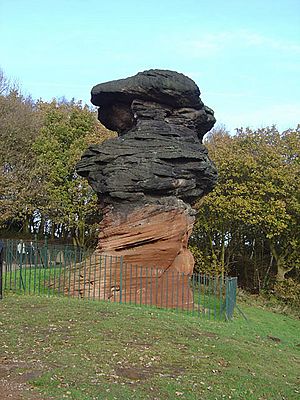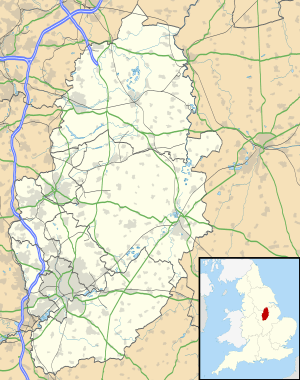Hemlock Stone facts for kids
Quick facts for kids Hemlock Stone |
|
|---|---|
| Himlack Stone | |
 |
|
| Location | Stapleford Hill, Stapleford, Nottinghamshire, England |
| Coordinates | 52°56′34.93″N 1°15′29.14″W / 52.9430361°N 1.2580944°W |
The Hemlock Stone, sometimes called the Himlack Stone, is a really cool natural rock formation. It stands tall on Stapleford Hill in Stapleford, Nottinghamshire, England. Think of it like a giant, lonely rock hill that stands out from everything around it. This type of rock formation is known as an inselberg.
Contents
The Hemlock Stone's Amazing Rocks
The Hemlock Stone is made of a type of rock called New Red Sandstone. This sandstone was formed over 200 million years ago! That was during a time in Earth's history called the Triassic Period.
The stone is about 28 feet (8.5 meters) high. It's made of two different layers of rock. The top part is called Nottingham Castle Sandstone. The bottom part is called Lenton Sandstone. Both of these layers are part of a bigger group of rocks known as the Sherwood Sandstone Group.
Why the Stone Has a "Waist"
The Nottingham Castle Sandstone at the top is made of medium to coarse grains of sand. These grains are stuck together very strongly, almost like super glue, by a mineral called baryte.
The Lenton Sandstone at the bottom has much finer grains. But, these grains are not stuck together as strongly. This means the bottom part of the stone is much easier to wear away.
Because the bottom wears away faster than the top, the stone has developed a "waisted" shape. This process is called differential erosion. It's like how a bar of soap gets thinner in the middle if you rub it unevenly.
How the Stone Was Formed
Scientists have two main ideas about how the Hemlock Stone ended up standing alone.
- Quarrying Idea: Back in the 1700s, a smart person named William Stukeley thought the stone was left behind because people had dug up and removed all the rock around it. There are indeed signs that people used to quarry (dig for stone) on and around Stapleford Hill.
- Natural Erosion Idea: In the early 1900s, another group of scientists thought the stone was shaped purely by nature. They believed that things like ice during the Ice Age wore away the surrounding rock.
Today, the main group of scientists who study rocks in Britain, the British Geological Survey, actually supports Stukeley's idea. They think quarrying played a big part in shaping the stone.
Studying the Stone Today
Even with these ideas, research on the Hemlock Stone continues! In 2015, experts from Nottingham University used a drone with special cameras to map the stone. They are still trying to learn more about its past as part of their "Three Stones Project."
Protecting the Stone
If you look closely at the top part of the Hemlock Stone, you might see some black grime. This grime is from industrial air pollution that happened a long time ago, before laws like the Clean Air Act 1956 helped clean up the air. This grime shows how slowly the top layer of rock wears away compared to the bottom.
The wind is still slowly wearing away the stone. Eventually, this could make the stone unstable. To protect this amazing natural landmark, an iron fence has been put around it. There's also a sign nearby that helps visitors understand the stone's history.
Images for kids



